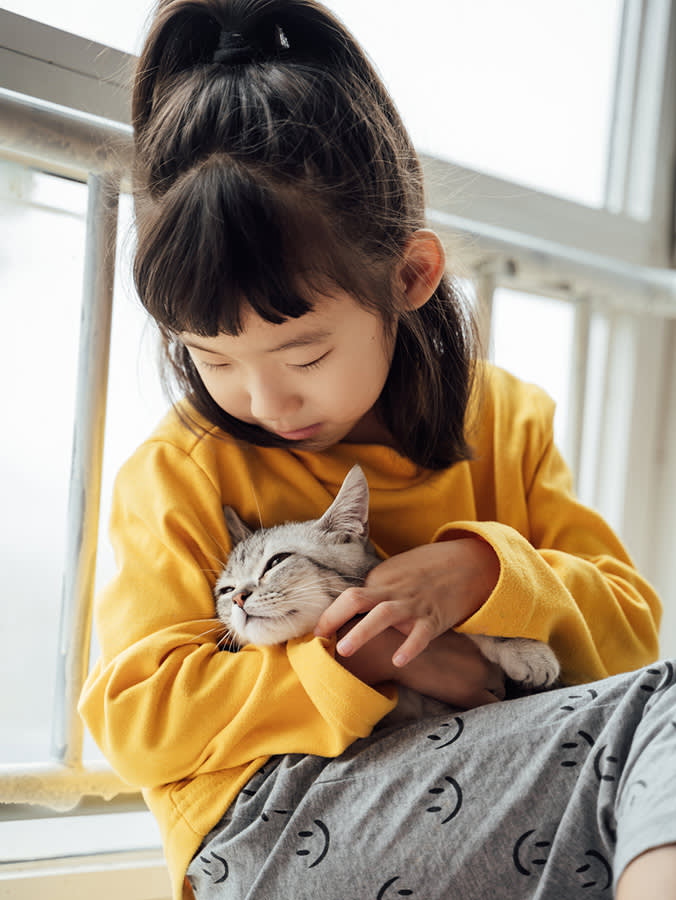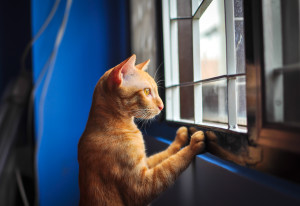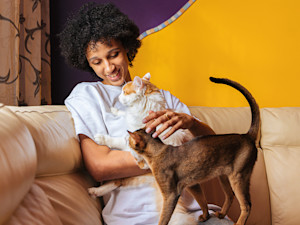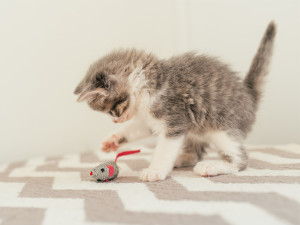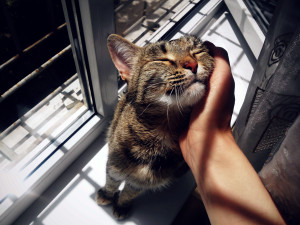How to Teach Your Kitty-Obsessed Kid How to Stroke a Cat
Boundaries are the name of the game with this one
Growing up, I was convinced that cats were kind of rubbish (don’t tell my cat, Toni Collette – people change!). Unlike the dogs I lived with, cats seemed avoidant, judgy and ready to attack. But when I started hanging out with my friends’ cats as an adult, I felt like I was witnessing some kind of Mandela effect: these cats were mellow little angels who just wanted to spend the day stretching under sunbeams and rubbing against cardboard. It took me an embarrassingly long time to realise that maybe cats as an entire species didn’t get more chilled; maybe I did.
Certified cat behaviourist Kristiina Wilson opens in new tab backs me up on this. “I think cats are perceived as hating children when really children just seem aggressive to them,” Wilson says. “They’re small, they’re lower to the ground, they’re very loud and they’re making these quick, jerky movements. The cats are like, ‘To me, this is what a predator seems like. I’m out of here.’”
Get (totally free) deals for food, treats, accessories, tech and way more pet parenting must-haves.
But – much like a cat’s – a kid’s behaviour isn’t set in stone. If we want kids and cats to get along, there are ways to teach a kid how to be someone a cat wants to hang out with. Below, Wilson gives her best tips on teaching kids how to chill with cats, so, unlike me, they can avoid years of misinformed anti-cat bias – and your cat can avoid years of being totally stressed out.
First: consent, consent, consent
Wilson points out that cats are the best teachers of consent. “Cats will absolutely let you know when they don’t like something, and I think that’s a really good lesson for kids to learn,” she says.
Unlike dogs, who often (but not always) love a random chin scratch from a new friend, cats like first meetings to be on their terms. “With kids, the first thing that you do is talk to the kid; tell them, ‘You have to be quiet, and you have to let the cat come to you; we’re not gonna approach the cat.’” This means looking over the cat’s head – not directly into their eyes – and letting the cat mosey over without making any loud or sudden movements. “Once they’ve come and checked you out, then they’ll usually sit down or be near you. Then, it’s okay to stick your hand out,” Wilson says.
Teaching kids how to read a cat’s body language
Although it sounds intimidating to try to teach a kid all the subtle signs cats use to communicate, Wilson assures me that it’s actually super fun for the kids. “Cats have their own language; I’ve found that kids love hearing that,” Wilson says. “They’re like, ‘Ooh, that sounds fun and secret.’” Let the kid know that what you’re about to teach them is a way of talking to animals, Dr Dolittle style. To most kids, that’s the dream.
Wilson adds: “You can say, ‘If the cat goes really puffy or its ears go back or it starts making noises at you, that’s a good sign to chill out and leave it alone. But if a cat looks friendly and comes up to you and its tail is up, then it’s telling you it wants to hang out and it’s okay to try to pet it.”
A hit cat communication tip with kids and adults alike? The famous slow blink. You should avoid too much eye contact because it can seem aggressive to cats, a well-placed slow blink can be effective after some trust has been established. “I’ve found that kids love that,” Wilson says. “If you tell them, ‘Another part of their secret language is if you slow blink at them, it means you’re a really nice person and you like them,’ kids immediately are like, ‘Oh, that’s so fun.’ That can go a long way toward them having a good communicative relationship with the cat because then they will also watch to see if the cat’s doing it, and it helps them be attuned to the cat’s body language.”
Teaching kids a cat’s preferences
After your kid knows a bit about how cats communicate, you can tell them that cats have some social preferences – just like we all do. Quiet voices and calm movements are the primary cat preferences a kid might need to practice.
Wilson recalls introducing a one-year-old to her cat, Steve: “I had to really work on that with the one year old because she loved screaming; it was just her happy sound,” Wilson says. “She’d get really excited when she’d see Steve and she’d scream. The cats would be like, ‘Toodeloo! We don’t like this!’ And then she’d be sad because she didn’t understand. She was just expressing how happy she was. But they have such good hearing that any really loud noise is going to adversely affect them.” If you explain to a kid that amazing hearing is one of a cat’s superpowers – along with high jumping, retractable claws and other Marvel-movie-ready feline skills – they’ll likely quiet down for a chance to befriend the super-kitty.
“The other thing is fast, jerky movements; those can be scary or seem aggressive to cats,” Wilson says. “Again, to kids, they’re normal, it’s just kind of how they operate.” Let the kid in your life know that moving in slo-mo is going to get them on the kitty’s good side.
Teaching kids how to stroke a cat
Stroking areas are another preference many cats share. According to Wilson, cats prefer to be stroked on the head and back, but not the tail and belly. “Those are no-no areas, especially if the cat doesn’t know you. It’s great to tell kids, ‘Just don’t ever touch those parts.’”
Strokes should be very gentle, especially to start. “You can show children how they like to be stroked on them or have them practice on your arm, just so they understand the amount of pressure and how to be gentle.” It should go without saying, but make sure the kid knows to never, ever pinch a cat. If the cat likes the touch, they’ll usually indicate so by rubbing or pushing against the kid’s hand.
Moving on to playtime
Wilson doesn’t recommend letting kids play with cats until there’s already some trust established; this might mean waiting for a few meetings before whipping out the toys. “Kids can get overly excited and that can seem aggressive to cats,” Wilson says. “You can move on to wand play and things like that later, once the kid and cat seem more adjusted to each other.”
During playtime, incorporating treats can be helpful. Give the kid a few of your cat’s very favourite snacks, so the cat associates the kid with positive, rewarding play. During playtime, let kids know that cats are hunters, so they want to stalk and chase a toy – which means it might seem a little slower than, say, playing fetch or tug-of-war with a dog. Wands should be flicked low to the ground at a bit of distance – not whipped in the cat’s face.
Never force it
If a cat’s not digging the attention and tries to ditch the scene, let them go. “Never hold or force the cat to participate in this,” Wilson says. “I think people might get a little frustrated if at first the cat is like, ‘I don’t want to deal with this,’ and just leaves, but you gotta let the cat dictate the situation. If you start restraining the cat or boxing the cat in a room where it can’t get away, you’re going to have a bad situation. You really want the cat to associate the kid with something great.”
Cats should have a safe place of their own to escape to, in case they do want the interaction to end. “Cats are really good at self-regulation, and they’ll genuinely just peace out when they’ve had it, as long as there’s space for them to go to,” Wilson says. Ideally, this space would be a separate room with a cat’s litter, food, and water, where the kids know they aren’t allowed to intrude.
It’s important not to rush anything – and not to lose hope. Sometimes cats are slow to warm to new people, period. It’s a matter of establishing trust, so it may take some time. “It’s just really being sure that the kid understands that this is all in the cat’s hands; it’s all about the cat’s consent and doing what is great for the cat,” Wilson says. “Most cats really do like children. It’s just that the children have to follow the right rules.”
